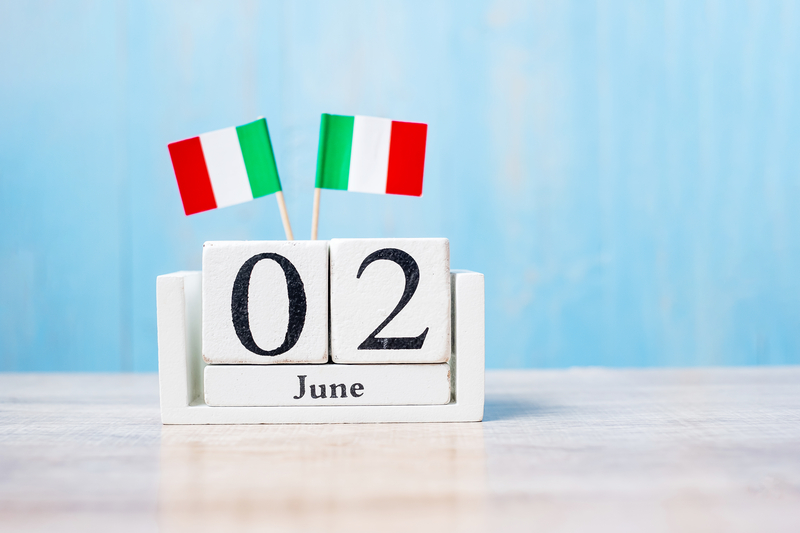“The Italian Republic: no longer a romantic dream of conspirators, an epic vision of poets; no longer a flag of rebellion and insurrection. The Italian Republic: a peaceful and lawful reality descended from the heights of ideals into the concrete realm of history, established without uprising or civil war into the regular practice of the constitution. […] Without massacres, without turmoil, without rancor, the Republic was born in Italy from this bitter and exhausting two-year trial, in which our resolve, instead of dissolving, matured and strengthened. For a moment, we can pause and be proud of ourselves: not to dwell on the endless mourning behind us or the immense reconstruction work ahead of us. Let us look up for a moment: dear shadows, you who pass by, paternal and fraternal, distant and recent, we have not betrayed you! Here is our Republic: not improvised, not born out of a day of turbulent passion, but a Republic that was desired, contemplated, patient, and reasoned. Not a surge of generous romantic illusion, but a prolonged test of civil conscience and regained reason.”
This is how Piero Calamandrei, a future founding father of the Italian constitution, wrote under the title “Miracle of Reason,” on the front page of Corriere della Sera on June 9, 1946. On that day, as announced by the newspaper, a ceremony at Montecitorio proclaimed the Italian Republic.
On June 2, Italians—and for the first time, Italian women—chose the future of their country by voting against the monarchy of King Umberto II. This pivotal date was later chosen to celebrate the birth of the Republic, even though it was only on June 13 that the Council of Ministers appointed Alcide De Gasperi as the provisional Head of State. On June 18, the Court of Cassation officially proclaimed the Republic’s birth, and on June 25, the Constituent Assembly met for the first time, definitively establishing the new institutional framework of the State.
However, as early as June 6, an editorial titled “Republican Dawn” by journalist Arrigo Jacchia in Il Messaggero captured the prevailing mood: “In the grand book of Italy’s history, today marks the end of one era and the dawn of a new one. The immense popular emotion is the only appropriate commentary on the imposing solemnity of this event. Rhetorical displays, philosophical dissertations, and classic literary references would sound intolerably false. Emerging from the national consciousness, one great reality stands out: the Monarchy has fallen, and the dawn of the Italian Republic has risen. This urgent and essential clarification came through the free vote of the Italian people, ending a compromising and unstable situation that harmed the country in every aspect. Italy has now given itself a clear direction and shown the world its form and objectives.”
After 85 years of rule by the Savoy dynasty (including 20 years of fascist dictatorship, ending with the tragedy of World War II), the Italians chose a constitutional republic. But the outcome was anything but easy or predictable. The royals, who had ruled Italy since 1861, tried every means to maintain their power, first attempting to block the vote and then to sabotage its outcome. However, on June 13, 1946, when it was clear that 12 million people had voted for the Republic and more than 10 million for the monarchy, Umberto II, the last King of Italy, had to leave the country. Italy was eager to change the course of history but remained deeply divided, as the 2 million vote difference revealed a strong monarchist presence in the South and the long process of reconciliation that lay ahead.
“The Republic,” Jacchia’s article continues, “must be a new fraternity for all Italians: it needs the willing and loyal contribution of all Italy’s children to rebuild the country. The victors must understand this; and those who did not win must accept the outcome of the ballot with discipline and a serene heart. […] There is an entire shattered economy to rebuild, industries to revive, paralyzed trade and commerce to reanimate. Above all, Italy’s right to not be misunderstood, plundered, or mutilated by the world must be defended. It’s an immense task! But we have immense, unconditional faith in the spiritual resources, work efficiency, and will to resurrect that animates our free people.”
The enthusiasm (and realism) is palpable, the desire to start anew from those who had endured the terrible war, hunger, pain, deprivation, death, and loss. The writing vividly conveys the feelings of that era. In a world on the brink of multiple conflicts, where everything seems taken for granted, from democracy to peace, it is perhaps crucial to remember how precious the history we have behind us truly is.
“La Repubblica italiana: non più un sogno romantico di cospiratori, un’immagine epica di poeti; non più una bandiera di ribellione e d’insurrezione. La Repubblica italiana: una realtà pacifica e giuridica scesa dall’empireo degli ideali nella concretezza terrena della storia, entrata senza sommossa e senza guerra civile nella pratica ordinaria della costituzione. […] Senza stragi, senza turbamenti, senza rancori la Repubblica è nata in Italia da questa amara e snervante prova di due anni, in cui la nostra volontà invece di dissolversi s’è maturata e rafforzata. Per un istante possiamo fermarci ed essere contenti di noi: non guardare gli infiniti lutti che sono alle nostre spalle, l’infinito lavoro di ricostruzione che è nel nostro avvenire. Guardiamo in alto per un istante: care ombre, che passate, paterne e fraterne, lontane e recenti non vi abbiamo tradito! Ecco la nostra Repubblica: non improvvisata, non balzata su in un giorno di torbida passione: Repubblica voluta, meditata, paziente, ragionata. Non un impeto di generosa illusione romantica, ma una prolungata prova di coscienza civile e di riacquistata ragione”.
Così scriveva sotto il titolo “Miracolo della ragione”, sulla prima pagina del Corriere della Sera, il futuro padre costituente Piero Calamandrei il 9 giugno 1946 nel giorno in cui, annunciava il giornale, una cerimonia a Montecitorio proclamava la Repubblica Italiana.
Il 2 giugno gli italiani, e per la prima volta le italiane, avevano scelto il futuro del proprio Paese votando contro la monarchia del re Umberto II. Questa data dirimente verrà poi scelta per celebrare la nascita della Repubblica anche se solo il 13 giugno il Consiglio dei ministri assegnò ad Alcide De Gasperi il ruolo di Capo provvisorio dello Stato, il 18 giugno la Corte di Cassazione proclamò ufficialmente la nascita della Repubblica, e il 25 giugno si riunì per la prima volta l’Assemblea costituente sancendo definitivamente il nuovo assetto istituzionale dello Stato.
Già il 6 giugno però, su Il Messaggero, l’editoriale “Alba repubblicana” firmato dal giornalista Arrigo Jacchia fotografava il clima che si respirava: “Sul gran libro della storia d’Italia è segnato da oggi: chiusura d’un ciclo, avvento di una nuova era. L’immensa emozione popolare è l’unico commento adeguato alla solennità imponente di questo fatto. Esibizioni retoriche, dissertazioni filosofiche, richiami letterari classicizzanti suonerebbero intollerabilmente falso. Emersa dalla coscienza nazionale, una sola grande realtà campeggia: la Monarchia è decaduta, l’alba dell’Italia repubblicana è sorta. Chiarificazione urgente e indispensabile. Il libero voto del popolo italiano ha messo termine a una situazione di compromesso e di instabilità che nuoceva sotto ogni aspetto al Paese. L’Italia si è data ora un orientamento deciso e ne ha mostrato al mondo le forme e gli obiettivi”.
Dopo 85 anni di regno della dinastia dei Savoia (di cui 20 di dittatura fascista, conclusa con la tragedia della Seconda Guerra Mondiale), gli italiani scelsero la Repubblica costituzionale. Ma fu un esito tutt’altro che facile o scontato. I reali, che avevano dominato l’Italia dal 1861, tentarono in tutti i modi di mantenere il potere, provando prima a impedire il voto e poi a boicottarne il risultato. Ma alla fine, il 13 giugno 1946, quando ormai era chiaro che 12 milioni di persone avevano votato per la Repubblica e più di 10 milioni per la monarchia, Umberto II, ultimo re d’Italia, dovette lasciare il Paese. Un Paese desideroso di cambiare il corso della storia ma ancora profondamente lacerato al suo interno se è vero che la forbice di 2 milioni di voti racconta di un fronte monarchico forte in tutto il Sud e del lungo lavoro di ricucitura che dovrà essere fatto.
“La Repubblica – continua l’articolo di Jacchia – ha da essere fraternità nuova di tutti gli Italiani: essa ha bisogno per rifare il Paese del concorso volenteroso e leale di tutti i figli d’Italia. Lo intendano i vincitori; accettino d’altra parte, disciplinatamente e con cuore sereno il responso delle urne coloro che tale responso non ebbero favorevole. […] C’è tutta una economia a pezzi da ricostruire, c’è una industria da rimettere in piedi, ci sono commerci e traffici paralizzati da rianimare. C’è soprattutto da difendere il diritto dell’Italia a non andare misconosciuta, taglieggiata, mutilata per il mondo. Immane fatica! Ma noi abbiamo una immensa, incondizionata fiducia nelle risorse spirituali, nella efficienza di lavoro, nella volontà di resurrezione che anima la nostra libera gente”.
E’ palpabile l’entusiasmo (e il realismo), la voglia di ricominciare di chi aveva patito la tremenda guerra, la fame, il dolore, le privazioni, le morti e le perdite. Lo scritto restituisce benissimo le sensazioni dell’epoca. In un mondo sul precipizio di più conflitti, in cui sembra tutto scontato, dalla democrazia alla pace, forse è proprio il caso di ricordarsi bene quanto è preziosa la Storia che abbiamo alle spalle.































